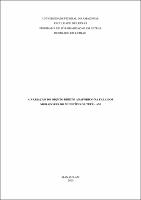| ???jsp.display-item.social.title??? |


|
Please use this identifier to cite or link to this item:
https://tede.ufam.edu.br/handle/tede/7792Full metadata record
| DC Field | Value | Language |
|---|---|---|
| dc.creator | Praia, Ana de Nazaré Egas | - |
| dc.creator.Lattes | http://lattes.cnpq.br/2966532175227629 | por |
| dc.contributor.advisor1 | Azevedo, Orlando da Silva | - |
| dc.contributor.advisor1Lattes | http://lattes.cnpq.br/2364892043249862 | por |
| dc.contributor.referee1 | Silva, Raynice Geraldine Pereira da | - |
| dc.contributor.referee1Lattes | http://lattes.cnpq.br/6871299150014070 | por |
| dc.contributor.referee2 | Corrêa, Hydelvídia Cavalcante de | - |
| dc.contributor.referee2Lattes | http://lattes.cnpq.br/4552974284166621 | por |
| dc.date.issued | 2020-03-04 | - |
| dc.identifier.citation | PRAIA, Ana de Nazaré Egas. A variação do objeto direto anafórico na fala dos moradores do Município de Tefé - AM. 2020. 98 f. Dissertação (Mestrado em Letras) - Universidade Federal do Amazonas, Manaus, 2020. | por |
| dc.identifier.uri | https://tede.ufam.edu.br/handle/tede/7792 | - |
| dc.description.resumo | A presente pesquisa quantitativa analisou o uso do objeto direto anafórico na fala dos moradores do município de Tefé - AM. Além disso, na fala tefeense, foram descritas as variantes do objeto direto anafórico; identificados os grupos de fatores linguísticos e extralinguísticos que influenciaram as ocorrências das variantes do objeto direto anafórico; e o falar tefeense foi caracterizado pela apropriação mais expressiva de uma das variantes do objeto direto anafórico. A pesquisa se baseou na Teoria da Variação e Mudança Linguística (LABOV, 2008 [1972]). Participaram deste estudo, 12 informantes pertencentes a três faixas etárias: I (18 – 35), II (36 - 55) e III (56 em diante). Em cada faixa etária, havia 2 informantes de ambos os sexos, masculino e feminino, e pertencentes a dois níveis de escolaridade (com 4 a 8 anos de escolarização e com 9 a 11 anos de escolarização). Na análise dos dados, foram levados em consideração os condicionadores linguísticos (animacidade do referente, flexão verbal de número) e extralinguísticos (idade, sexo e escolaridade). Os resultados deste trabalho mostram que a variante clítico acusativo está em desuso na fala da comunidade investigada. Por outro lado, o objeto nulo (ausência do objeto direto) foi a forma mais incidente em todos os grupos de fatores, tanto linguísticos, quanto extralinguísticos; enquanto o pronome lexical (ele[s]/ela[s]) foi a segunda opção de retomada do objeto direto anafórico, e o sintagma nominal (repetição do SN pleno) obteve um menor percentual em todos os contextos. | por |
| dc.description.abstract | The present quantitative research analyzed the use of the direct anaphoric object in the speech of the residents of the municipality of Tefé - AM. In addition, in Tefeense speech, variants of the anaphoric direct object were described; the linguistic and extra-linguistic factor groups that influenced the occurrences of the anaphoric direct object variants were identified; and the Tefeense speech was characterized by the most expressive appropriation of one of the variants of the anaphoric direct object. The research was based on the Theory of Variation and Linguistic Change (LABOV, 2008 [1972]). Twelve informants participated in this study belonging to three age groups were selected: I (18 - 35), II (36 - 55) and III (56 onwards). In each age group, there were 2 informants of both genders, male and female, belonging to two levels of education (with 4 to 8 years of schooling and with 9 to 11 years of schooling). In the analysis of the data, linguistic conditioners (referring animacity, verbal inflection of number) and extralinguistic conditions (age, sex and education) were taken into account. The results of this work show that the accusative clitic variant is in disuse in the speech of the investigated community. On the other hand, the null object (absence of the direct object) was the most incident form in all groups of factors, both linguistic and extralinguistic; while the lexical pronoun (he, she, it, they) was the second option of resuming the anaphoric direct object, and the nominal phrase (repetition of the full SN) obtained a lower percentage in all contexts. | por |
| dc.description.sponsorship | Fundação de Amparo a Pesquisa do Estado do Amazonas - FAPEAM | por |
| dc.format | application/pdf | * |
| dc.thumbnail.url | https://tede.ufam.edu.br//retrieve/38759/Disserta%c3%a7%c3%a3o_AnaEgasPraia_PPGL.pdf.jpg | * |
| dc.language | por | por |
| dc.publisher | Universidade Federal do Amazonas | por |
| dc.publisher.department | Faculdade de Letras | por |
| dc.publisher.country | Brasil | por |
| dc.publisher.initials | UFAM | por |
| dc.publisher.program | Programa de Pós-graduação em Letras | por |
| dc.rights | Acesso Aberto | por |
| dc.subject | Sociolinguística | por |
| dc.subject | Língua portuguesa - Regionalismos | por |
| dc.subject | Anáfora (Linguística) | por |
| dc.subject | Teoria da Variação e Mudança Linguística | por |
| dc.subject | Tefé (Amazonas) | por |
| dc.subject.cnpq | LINGUÍSTICA, LETRAS E ARTES | por |
| dc.title | A variação do objeto direto anafórico na fala dos moradores do Município de Tefé - AM | por |
| dc.type | Dissertação | por |
| dc.subject.user | Sociolinguística | por |
| dc.subject.user | Objeto Direto Anafórico | por |
| dc.subject.user | Fala Tefeense | por |
| Appears in Collections: | Mestrado em Letras | |
Files in This Item:
| File | Description | Size | Format | |
|---|---|---|---|---|
| Dissertação_AnaEgasPraia_PPGL.pdf | Dissertação_AnaEgasPraia_PPGL | 1.75 MB | Adobe PDF |  Download/Open Preview |
Items in DSpace are protected by copyright, with all rights reserved, unless otherwise indicated.




